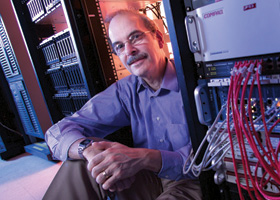Feature Story
Health Center Today, August 6, 2010
Uncovering the Mysteries of Human Cells
By Lisa Catanese
Each of the 100 trillion cells in the human body is a tiny parcel of water and chemicals containing the entire human genome – all of the DNA that an individual possesses. For Leslie Loew and his team of researchers, uncovering the mysteries of these cells and how they behave in the body is a mission, a fascination, a pursuit that can lead to a better understanding of diseases and how best to treat them.
Loew, a professor of cell biology, is the director of the Health Center’s Richard D. Berlin Center for Cell Analysis and Modeling (CCAM). The CCAM is developing new approaches to determine how cells work, interact, and respond – and how to organize this data so it can be applied to human health.
The CCAM integrates state-of-the-art microscope technologies with computational tools that produce realistic models of cell dynamics. The innovative work performed at the CCAM has received worldwide attention and millions in annual grant support since the Center was established in 1994.
The CCAM brings together biomedical researchers from various disciplines in a setting that supports and reinforces the value of collaboration. “Our Center is unique in that we have chemists, physicists, mathematicians, biologists, and computer scientists all working together,” Loew explains. “We were far ahead of our time when we started these interdisciplinary groups.”
The CCAM is the home of the Virtual Cell, a computerized environment for cell modeling and simulation. Designated and funded as a National Resource by the National Institutes of Health (NIH), the Virtual Cell is a distributed application that is available via the Internet, serving as a tool for scientists and freely accessible to all members of the scientific community.
With the Virtual Cell, investigators can build complex models using a web-based interface. The creation of these models can range from simple, to evaluate hypotheses or interpret data, to complicated multi-layered models to probe the predicted behavior of complex systems.
“More than 2,000 labs around the world are using the Virtual Cell,” Loew points out. “The NIH grant mandates that we continuing building software to support it and to make sure there is access to it.” To support these efforts, for example, are annual short courses to enable cell biologists and biophysicists to develop a Virtual Cell model of their experimental system.
A current study by Loew’s team at the CCAM is a project in conjunction with the Mt. Sinai School of Medicine and Columbia University to determine how human kidney cells are regulated to produce the delicate filtration system that allows the kidney to function. The project has been awarded a five-year, $6 million grant from the NIH’s Transformative Research Project Program (RO1), which supports innovative research with the potential for major impact on human health.
In this study, the Virtual Cell is being used to develop computational models of how cells interact within kidney tissues, identifying general principles for assembling functional tissues that can aid in understanding disease processes and for screening for new drugs.
Another example of current Virtual Cell research is a study by M.D./Ph.D. candidate Sherry-Ann Brown that examines the way in which signals in the brain are transferred across synapses and neurons. Genetic defects in these biochemical pathways are linked to ataxia, in which an individual’s motor coordination, speech, handwriting, and balance are impacted. The Virtual Cell research can lead to a better understanding of brain cell function which, in turn, could result in advances in prevention, diagnosis, and treatment.
The CCAM provides a vast array of laboratory equipment that can be used for obtaining experimental data needed to create and enhance Virtual Cell models. Among the CCAM’s $8 million in major equipment are confocal and laser optical microscopes, multiprocessor computers, and spectrometers that use light to study matter.
The Center recently moved to the new Cell and Genome Sciences Building, which was designed to promote interdisciplinary research in a wide range of projects. In addition to the CCAM, the building also houses the UConn Stem Cell Institute, the Department of Genetics and Developmental Biology, and UConn’s Office of Technology Commercialization (including the Technology Incubation Program – UConn’s business incubator), enhancing the university’s role as a leader in innovative research and technology in these areas.
The CCAM, and especially the Virtual Cell, is the culmination of decades of work for Loew, who began his career in an academic chemistry department. “Some of the technology I was developing could be applied to asking questions about how cells behave,” he says of his academic research. “It soon became clear to me that I was only going to enjoy developing these tools if I could use them myself.”



